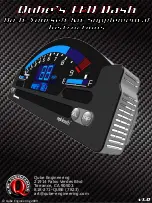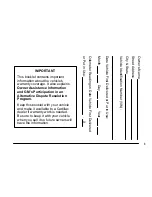
Note:
When the sealing compound
is first added into the tire, the air
pressure gauge reading (7) on the
compressor unit may increase up to
90 psi; this is normal and should be
no reason for concern. The pressure
will drop after about 30 seconds of
operation.
Do not stand directly over the temporary mobility kit while
inflating the tire. If you notice any unusual bulges or
deformations in the tire’s sidewall during inflation, stop the air
compressor and deflate the tire using the pressure release valve. The
pressure release valve is located on the hose.
8. Inflate the tire until the tire reaches the recommended placard
pressure, then turn the air compressor off by pressing the “O” side of the
orange button.
Note:
If the damaged tire does not reach the recommended placard
pressure within nine minutes, the tire is too severely damaged and the
car must not be driven. Call for roadside assistance.
9. Once the tire pressure reaches the recommended placard pressure,
quickly unscrew the hose from the tire’s air valve and reinstall the valve
cap. Unplug the electrical plug from the power point. Turn the sealing
compound container back to its original position and close the safety
latch. Stow the temporary mobility kit back in the original location. You
will need it again to check the tire’s air pressure in the second stage of
this operation.
10.
Immediately, and cautiously, drive the vehicle a short distance
(approximately two miles [3.2 km]) to activate the sealing
compound within the damaged tire. Do not exceed 50 mph
(80 km/h).
Note:
If you experience any unusual vibration, ride disturbance or noise
while driving, reduce your speed until you can safely pull off to the side
of the road to call for roadside assistance.
Do not proceed to the
second stage of this operation.
2008 05+ Mustang
(197)
Supplement
USA
(fus)
Roadside Emergencies
20
















































